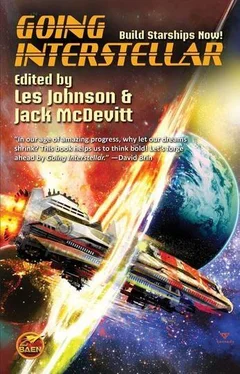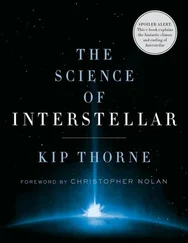“Thanks to you,” she said.
Before he could think of a reply, Gregorian raised his glass of amber liquor over his head and bellowed, “To Dr. Alexander Alexandrovich Ignatiev. The man who saved our lives.”
“The man who steers across the stars,” added one of the biologists.
They all cheered.
Ignatiev basked in the glow.
They’re children, he said to himself. Only children.
But they’re my children. Each and every one of them. The idea startled him. And he felt strangely pleased.
He looked past their admiring gazes to the display screen and the pinpoints of stars staring steadily back at him. An emission nebula gleamed off in one corner of the view. He felt a thrill that he hadn’t experienced in many, many years.
It’s beautiful, Ignatiev thought. The universe is so unbelievably, so heart-brimmingly beautiful: mysterious, challenging, endlessly full of wonders.
There’s so much to learn, he thought. So much to explore. He smiled at the youngsters crowding around him. I have some good years left. I’ll spend them well.
ANTIMATTER STARSHIPS
Dr. Gregory Matloff
Dr. Greg Matloff is a leading expert in possibilities for interstellar propulsion. He recently retired from his position as a tenured astronomy professor with the physics department of New York City College of Technology, CUNY. He has served as a consultant for NASA, a Hayden Associate of the American Museum of Natural History, a Fellow of the British Interplanetary Society, and a Corresponding Member of the International Academy of Astronautics.
Greg coauthored with Les Johnson and C Bangs Living Off the Land in Space, the monograph Deep-Space Probes , and he wrote The Starflight Handbook in collaboration with Eugene Mallove (1989). His papers on interstellar travel and methods of protecting Earth from asteroid impacts were published in The Journal of the British Interplanetary Society , Acta Astronautica , Spaceflight, Space Technology , The Journal of Astronautical Sciences , and Mercury . In 1998, he won a $5,000 prize in the international essay contest on Extraterrestrial Intelligence sponsored by the National Institute for Discovery Science.
In this, the first of his two essays for this anthology, Greg explains the fundamental physics of antimatter propulsion. Yes, antimatter is real but its use will be challenging indeed….
* * *
Most readers of this bookhave heard of antimatter. Because of that fictional engineer Scotty on the Starship Enterprise in the original Star Trek , most readers know that it is both exceptionally energetic and very difficult to store. Scotty, in fact, spends a great deal of time trying to maintain the stability of the ship’s antimatter “core” and making sure that the stuff does not come in contact with the walls of the core’s containment vessel, which is composed of ordinary matter. If he were to fail in this endeavor, the ship would immediately explode and be visible across the galaxy as a miniature, short-lived supernova.
If you’ve read Dan Brown’s thriller Angels and Demons or seen the Hollywood movie version, you know that this material can be produced in nuclear accelerators such as the Large Hadron Collider in the CERN, located on the French-Swiss border. And you know that in the wrong hands, even a tiny quantity of antimatter could be used to commit terrorist acts such as blowing up the Vatican.
But what is this stuff? How do we know about it? Does it exist in nature? How can we produce and store it? And, how effective might it be in propelling an interstellar spacecraft?
Early Antimatter History
Antimatter belongs to a mirror world. The anti-electron or positron, for example, has the same mass as the electron but an opposite (positive) electrical charge. Because their electric charges are opposite and opposite charges attract, electrons and positrons attract each other. When they touch, they mutually annihilate one another and their energy appears in the form of a gamma-ray photon.
It was the British physicist Paul A. M. Dirac who predicted in the 1930s that such a mirror world would exist. In his development of a relativistic theory of the electron, Dirac may have been the first to realize that the vacuum is far from empty.
The concept of a dynamic vacuum is hard to swallow by most people schooled in classical physics. After all, we are all taught in secondary school that a perfect vacuum is totally empty—devoid of all matter. And everyone who has followed extra-vehicular activity in space or seen the science fiction movie 2001: A Space Odyssey , knows how quickly a human astronaut would die if exposed without a spacesuit to the hard vacuum of interplanetary space.
But Dirac chose to view the universal vacuum on the tiny scales of quantum mechanics. In very small portions of space and on infinitesimal time intervals, a better model for the vacuum is the dynamic sea. Think of an ocean wave—the peak of the wave corresponding to a positive vacuum energy state and the trough analogous to a negative vacuum energy state. In Dirac’s theory, every sub-atomic particle in the “positive-energy” universe that we inhabit has a “negative-energy” analog. The negative-energy analog of the electron (also considered a “hole” in Dirac’s “sea”) is the positron. When the two meet, the result is a neutral state corresponding to calm water in the ocean.
Science, unlike deductive philosophy, requires experimental or observational confirmation of brilliant theoretical ideas. It was the American physicist Carl Anderson, working at Caltech, who discovered the track of a positively charged electron in cloud chamber photographs of cosmic ray tracks in 1932. For this discovery, which was confirmed by others, Anderson shared the 1936 Nobel Prize in Physics.
Positrons actually can be found in other places. For example, they are produced when carbon-11 naturally decays into boron-11. But there are no known radioactive decay schemes that release the positron’s big brother, the antiproton.
Because protons and antiprotons are almost two thousand times as massive as electrons and positrons, a more energetic strategy was required to search for the antiprotons. The instrument used to do the trick was the 6.5 billion electron volt proton accelerator called the Bevatron at the Lawrence Radiation Lab, which was at University of California at Berkeley.
Antiprotons were initially produced by bombarding a stationary target with a high-energy proton beam accelerated by the Bevatron. The discovery was announced in the November 1, 1955 issue of Physical Review Letters by Owen Chamberlain, Emilio Segre, Clyde Wiegand and Thomas Ypsilantis. Chamberlain and Segre shared the 1959 Nobel Prize for this discovery.
It is known today that most or all particles have corresponding antiparticles. This is even true for electrically neutral particles such as the neutron. The antineutron is also electrically neutral, but it has other properties opposite that of the neutron.
Because of the inefficiencies involved in antimatter production, matter-antimatter reactors will almost certainly never be a solution to the energy requirements of our global civilization.
Antimatter in the Early Cosmos
Since antimatter is essentially non-existent on Earth, one might hope that we will someday locate a cosmic repository for it. Unfortunately, since cosmic-ray studies put an upper limit on the universal antimatter/matter ratio under 0.0001, the odds do not look very good for locating such a source.
Читать дальше












